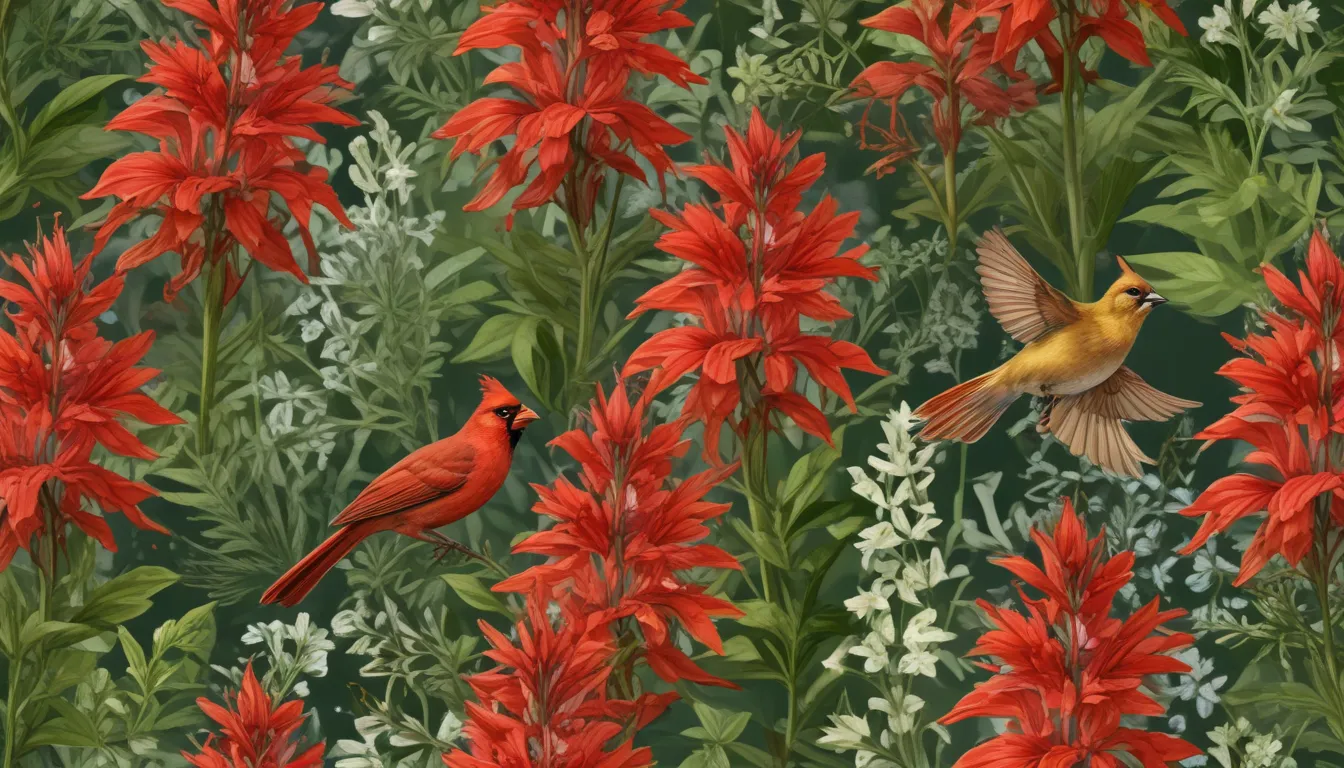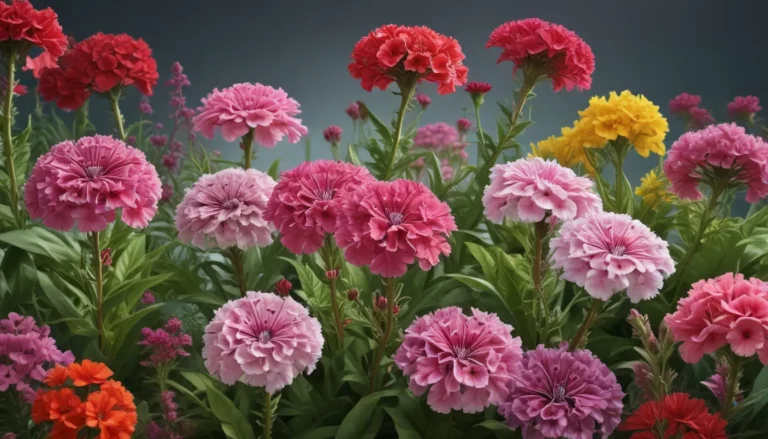The pictures we use in our articles might not show exactly what the words say. We choose these pictures to make you interested in reading more. The pictures work together with the words but don’t take their place. The words still tell you the important facts.
Are you captivated by the vibrant beauty of Cardinal Flower? This stunning native North American plant, also known as Lobelia cardinalis, can be found in wetlands, meadows, and along the edges of streams and ponds. Beyond its visual appeal, Cardinal Flower boasts a wealth of characteristics and properties that make it truly remarkable. Join us as we unravel 20 surprising facts about this captivating plant, exploring its historical significance, ecological importance, and unique adaptations.
The Cardinal Flower: A Striking Perennial Plant
Native to North America, the Cardinal Flower belongs to the Campanulaceae family and is renowned for its vivid red blooms. The name "Cardinal Flower" stems from the striking resemblance of its petals to the bright red robes worn by Catholic cardinals, adding a vibrant touch to any garden or landscape.
A Magnet for Hummingbirds and Butterflies
Evolved to attract hummingbirds and butterflies, the Cardinal Flower's bright red color and tubular shape make it irresistible to these pollinators. Its nectar-rich blooms act as a beacon, drawing these delicate creatures to feed.
Thriving in Moist, Well-Draining Soil
Preferring moist soil conditions near streams, ponds, or rain gardens, the Cardinal Flower requires well-draining soil to prevent waterlogged conditions and root rot. Its adaptability to wet environments makes it a standout choice for water-loving gardens.
Medicinal Properties of Cardinal Flower Leaves
Traditionally used by Native Americans for medicinal purposes, the leaves of the Cardinal Flower boast healing properties. From treating headaches to respiratory issues and digestive problems, this plant has a long history of health benefits.
A Favorite Among Gardeners
Gardeners are drawn to the Cardinal Flower for its visual appeal and ability to attract pollinators. Whether in flower beds, borders, or naturalized areas, these striking plants add a touch of elegance and biodiversity to any landscape.
Late Summer to Early Fall Bloomer
With a blooming period from late summer to early fall, the Cardinal Flower injects vibrant color into the late-season garden. Long-lasting blossoms ensure a picturesque display that lasts for weeks.
Towering Heights of Up to 4 Feet
Standing tall at heights of up to 4 feet, Cardinal Flowers command attention in the garden with their upright growth habit and showy flowers. Their imposing presence makes them a captivating focal point.
Low-Maintenance Elegance
Easy to care for and resistant to pests and diseases, Cardinal Flowers are a hassle-free addition to any garden. Minimal maintenance requirements make them a delightful choice for both novice and experienced gardeners.
Symbol of Hope and Strength
Throughout history, the Cardinal Flower has symbolized qualities such as hope, strength, and positivity. Its vibrant appearance and cultural significance have elevated it to a symbol of endurance and resilience.
Perfect for Rain Gardens
Ideal for rain gardens due to their affinity for moist soil, Cardinal Flowers play a vital role in eco-friendly landscaping. By collecting and filtering rainwater, these plants contribute to sustainable gardening practices.
A Delight for Pollinators
While hummingbirds and butterflies take center stage in pollinating Cardinal Flowers, bees also play a role in seed production. By attracting a diverse range of pollinators, these plants support biodiversity and ecosystem health.
Resistant to Deer
Deer-resistant properties make Cardinal Flowers a practical choice for gardens in areas with high deer populations. Their ability to withstand browsing helps preserve their beauty and integrity.
Propagation Through Division
Multiplying Cardinal Flowers is a simple task that involves dividing clumps and replanting them in various garden areas. This propagation method allows you to spread the beauty of these stunning plants.
A Favorite Among Photographers and Nature Enthusiasts
The striking beauty of Cardinal Flowers makes them a popular subject for photographers and nature lovers alike. Their vibrant red blooms and photogenic allure captivate enthusiasts and professionals alike.
Symbol of Love and Passion
In the language of flowers, Cardinal Flower signifies love, passion, and desire. Its fiery red color evokes strong emotions and romantic sentiments, making it a meaningful gift or addition to symbolic arrangements.
Explore the World of Cardinal Flower
In conclusion, Cardinal Flowers are a treasure trove of benefits that enrich our surroundings. From attracting pollinators to offering medicinal properties, these plants are a valuable addition to any garden or habitat. Their adaptability, sustainable nature, and cultural symbolism make them a timeless choice for nature lovers, garden enthusiasts, and anyone seeking to enhance their outdoor space.
FAQs
- How tall can Cardinal Flowers grow?
-
Cardinal Flowers can reach heights of 3 to 4 feet, adding vertical interest to your garden.
-
Can Cardinal Flowers tolerate shade?
-
While preferring full sun, Cardinal Flowers can tolerate some shade, especially during the hottest part of the day.
-
Are Cardinal Flowers easy to grow?
-
While growing Cardinal Flowers from seeds can be challenging, once established, they are low-maintenance plants.
-
How do I attract hummingbirds with Cardinal Flowers?
-
Planting Cardinal Flowers in clusters and providing hummingbird feeders nearby can attract these delightful creatures to your garden.
-
Are Cardinal Flowers deer-resistant?
-
Unfortunately, Cardinal Flowers are not deer-resistant and may require protection in areas with high deer populations.
-
Can I grow Cardinal Flowers in containers?
-
Cardinal Flowers can be grown in containers with proper drainage and sufficient space for their root system.
-
When is the best time to plant Cardinal Flowers?
- Plant Cardinal Flowers in the spring after the last frost date to allow them time to establish before summer.
Join us on a journey of discovery as we unravel the enchanting world of Cardinal Flower. Whether you're an avid gardener or a nature enthusiast, there's always more to learn and appreciate about these captivating plants. Let your curiosity bloom alongside the vibrant red blossoms of Cardinal Flower, and immerse yourself in the beauty and wonder of nature's creations.






